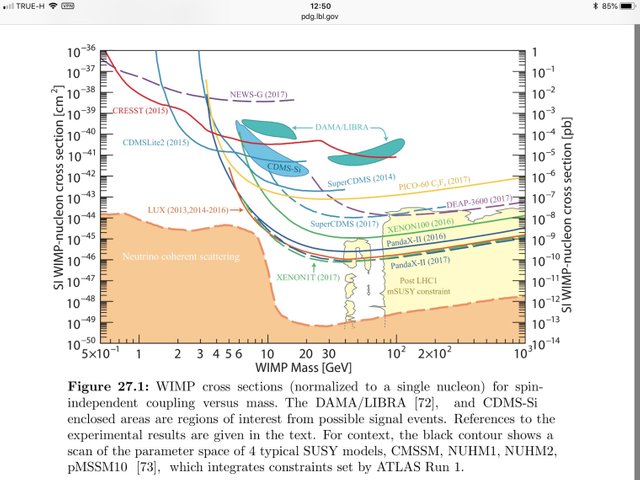WIMPZillas
In the search for direct detection of dark matter, the experimental focus has been on WIMPS – weakly interacting massive particles. Large crystal detectors are placed deep underground to avoid contamination from cosmic rays and other stray particles.
WIMPs are often hypothesized to arise as supersymmetric partners of Standard Model particles. However, there are also WIMP candidates that arise due to non-supersymmetric extensions to the Standard Model.
The idea is that the least massive supersymmetric particle would be stable, and neutral. The (hypothetical) neutralino is the most often cited candidate.
The search technique is essentially to look for direct recoil of dark matter particles onto ordinary atomic nuclei.
The only problem is that we keep not seeing WIMPs. Not in the dark matter searches, not at the Large Hadron Collider whose main achievement has been the detection of the Higgs boson at mass 125 GeV. The mass of the Higgs is somewhat on the heavy side, and constrains the likelihood of supersymmetry being a correct Standard Model extension.
The figure below shows WIMP interaction with ordinary nuclear matter cross-section limits from a range of experiments spanning from 1 to 1000 GeV masses for WIMP candidates. Typical supersymmetric (SUSY) models are disfavored by these results at higher masses above 40 GeV or so as the observational limits are well down into the yellow shaded regions.

Perhaps the problem is that the WIMPs are much heavier than where the experiments have been searching. Most of the direction detection experiments are sensitive to candidate masses in the range from around 1 GeV to 1000 GeV (1 GeV or giga-electronVolt is about 6% greater than the rest mass energy of a proton). The 10 to 100 GeV range has been the most thoroughly searched region and multiple experiments place very strong constraints on interaction cross-sections with normal matter.
WIMPzillas is the moniker given to the most massive WIMPs, with masses from a billion GeV up to potentially as large as the GUT (grand Unified Theory) scale of 10^{16} GeV .
The more general term is Superheavy Dark Matter, and this is proposed as a possibility for unexplained ultra high energy cosmic rays (UHECR). The WIMPzillas may decay to highly energetic gamma rays, or other particles, and these would be detected as the UHECR.
UHECR have energies greater than a billion GeV (10^9 GeV) and the most massive event ever seen (the so-called Oh My God Particle) was detected at 3 \cdot 10^{11} GeV . It had energy equivalent to a baseball with velocity of 94 kilometers per hour. Or 40 million times the energy of particles in the Large Hadron Collider.
It has taken decades of searching at multiple cosmic ray arrays to detect particles at or near that energy.
Most UHECR appear to be spatially correlated with external galaxy sources, in particular with nearby Active Galactic Nuclei that are powered by supermassive black holes accelerating material near, but outside of, their event horizons.
However, they are not expected to be able to produce cosmic rays with energies above around 10^{11} GeV , thus the WIMPzilla possibility. Again WIMPzillas could span the range from 10^9 GeV up to 10^{16} GeV .
In a paper published last year, Kolb and Long calculated the production of WIMPzillas from Higgs boson pairs in the early universe. These Higgs pairs would have very high kinetic energies, much beyond their rest mass.
This production would occur during the “Reheating” period after inflation, as the inflaton (scalar energy field) dumped its energy into particles and radiation of the plasma.
There is another production mechanism, a gravitational mechanism, as the universe transitions from the accelerated expansion phase during cosmological inflation into the matter dominated (and then radiation-dominated) phases.
Thermal production from the Higgs portal, according to their results, is the dominant source of WIMPzillas for masses above 10^{14} GeV . It may also be the dominant source for masses less than about 10^{11} GeV .
They based their assumptions on chaotic inflation with quadratic inflation potential, followed by a typical model for reheating, but do not expect that their conclusions would be changed strongly with different inflation models.
It will take decades to discriminate between Big Bang-produced WIMPzilla style cosmic rays and those from extragalactic sources, since many more 10^{11} GeV and above UHECRs should be detected to build statistics on these rare events.
But it is possible that WIMPzillas have already been seen.
The density is tiny. The current dark matter density in the Solar neighborhood is measured at 0.4 Gev per cc. Thus in a cubic meter there would be the equivalent of 400,000 proton masses.
But if the WIMPzillas are at energies 10^{11} Gev and above (100 billion GeV), a cubic kilometer would only contain 4000 particles at a given time. Not easy to catch.
References
http://cdms.berkeley.edu/publications.html – SuperCDMS experiment led by UC Berkeley
http://pdg.lbl.gov/2017/reviews/rpp2017-rev-dark-matter.pdf – Dark matter review chapter from Lawrence Berkeley Lab (Figure above is from this review article).
http://home.physics.ucla.edu/~arisaka/home3/Particle/Cosmic_Rays/ – Ultra high energy cosmic rays
https://arxiv.org/pdf/1708.04293.pdf – E. Kolb and A. Long, 2017 “Superheavy Dark Matter through Higgs Portal Operators”
Congratulations @surfdog888! You have received a personal award!
Click on the badge to view your Board of Honor.
Congratulations @surfdog888! You received a personal award!
You can view your badges on your Steem Board and compare to others on the Steem Ranking
Vote for @Steemitboard as a witness to get one more award and increased upvotes!